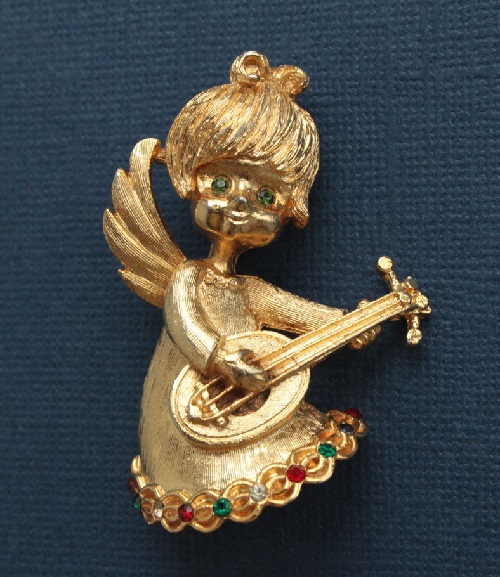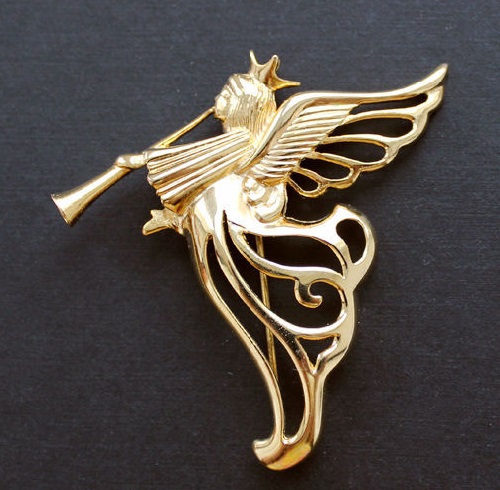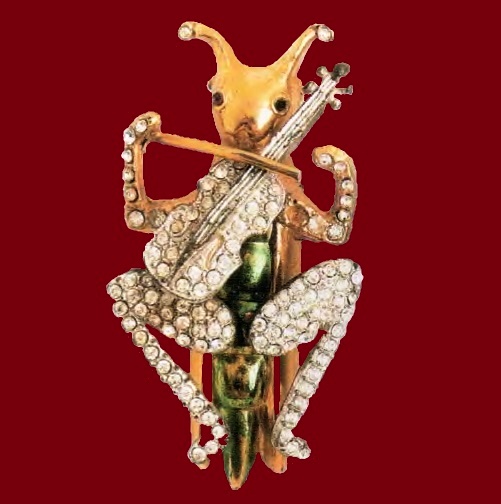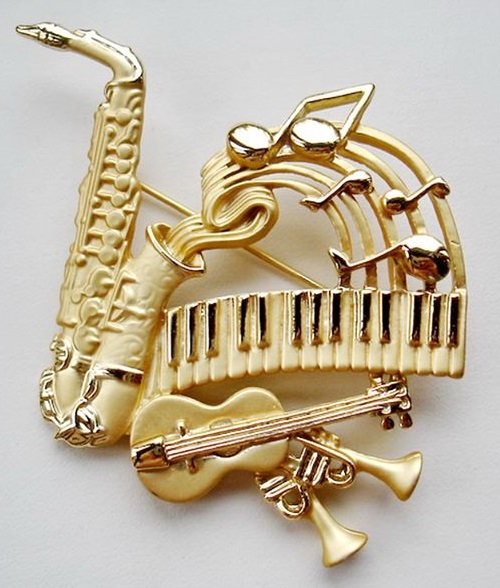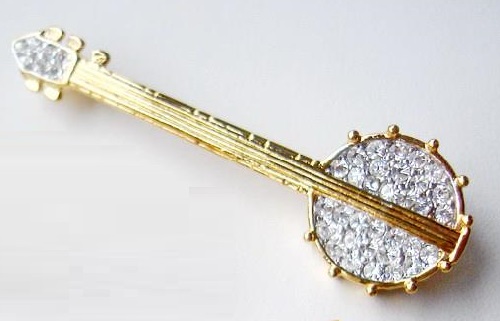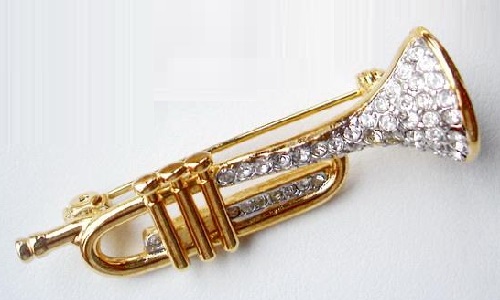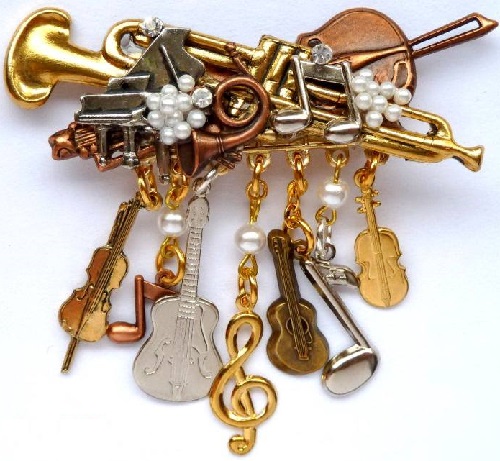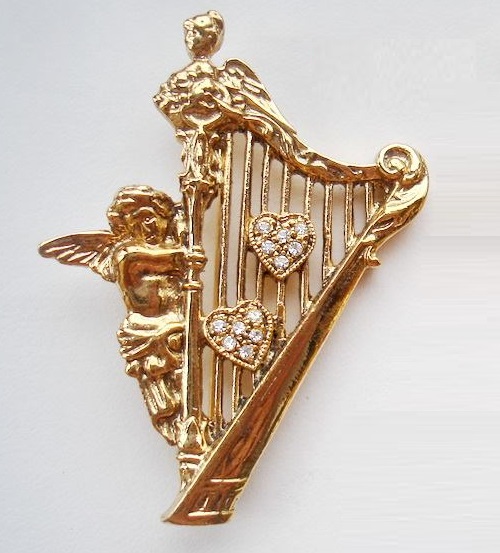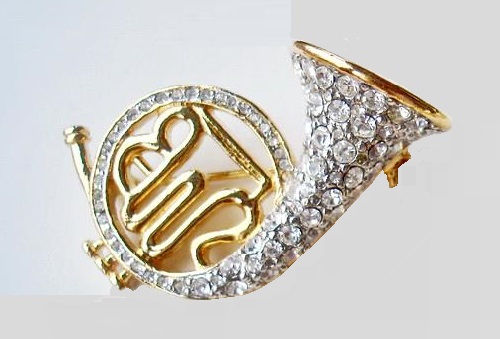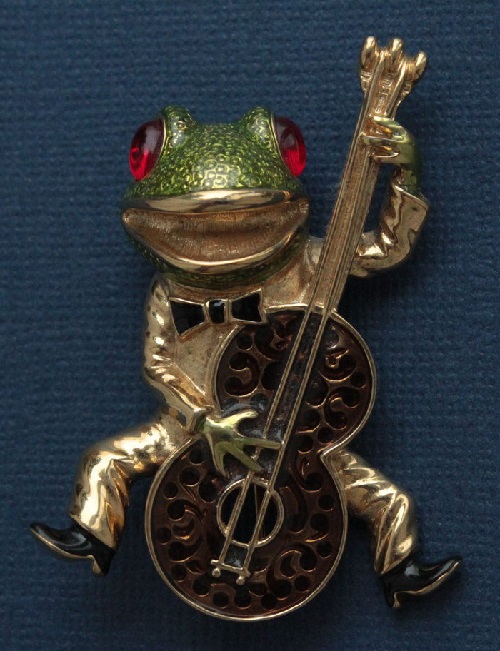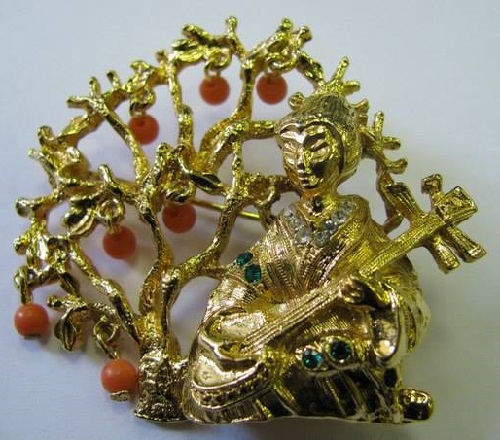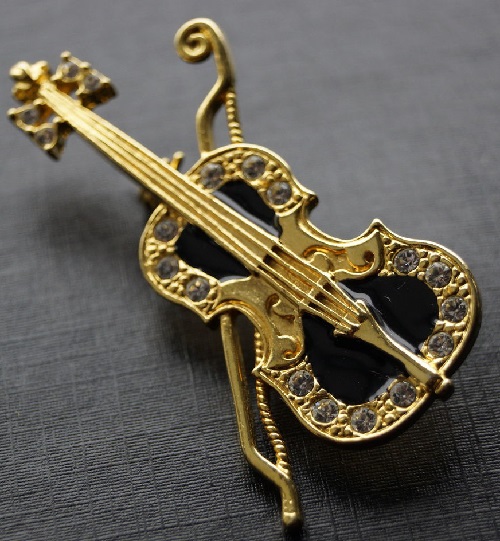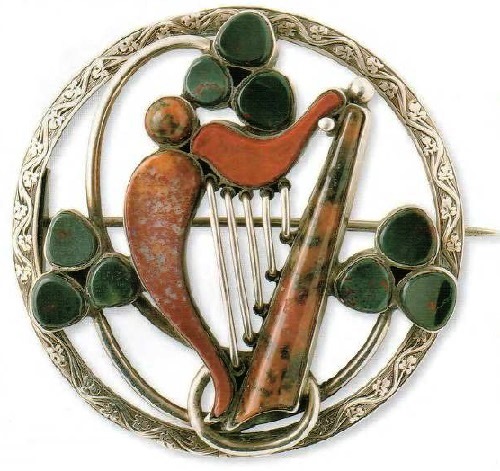Musical instruments in jewellery

Playing musical instruments medieval ladies – harp, lute and violin. MFA brooch. Musical instruments in jewellery. Galina Karputina collection
Musical instruments in jewellery
Traditionally, a part of world culture, Musical instruments often become the inspiration for jewellery designers. And it is difficult to find a musical instrument that had not been incarnated in jewelry – harp, lute, violin, Alto horn, piano, viola, guitar, mandolin, banjo, flute and many more.
♦ Viola, the alto member of the violin family. There is no standard size, and body lengths vary from 400 mm to 479 mm. It evolved in the mid-17th century, when used in orchestras as mezzo-soprano, alto, and tenor, and the size of the instrument suiting the range of the music. The tuning was the same for all three, irrespective of size.
The viola da braccio and the viola da gamba (Italian, ‘arm viola’ and ‘leg viola’) are terms that came into use in Italy in the 16th century to distinguish between the violin family (da braccio) and the viols (da gamba). The viola d’amore was an 18th-century instrument roughly of viola size, which had sympathetic strings.
♦ Cello (violoncello), historically the bass of the violin family. Its vast range—in solo works the note C, for example, may be sounded in five different octaves—and its huge expressive powers render the cello – the great solo instrument of the family after the violin itself. A little over twice the size of the violin, its great depth of body is nearly four times that of a violin, bringing the internal air-resonance frequency down to nearly a twelfth lower. The strings are thicker than violin strings and under about twice the tension.
The instrument seems to have been first seriously developed in the late 17th century in Cremona, and some 63 cellos made by Antonio Stradivari (c. 1644 – 1737) still exist. From the 18th century the cello developed into a virtuoso solo instrument: concertos have been written for it by many composers including Boccherini (himself a cellist], Beethoven, Schumann, Elgar, and many others. There have been many outstanding cellists, perhaps the greatest being Casals, though Rostropovich rivals him for this position.

Alto horn Vintage Brooch 1980s, jewelry made of alloy gold color. The entire surface of the instrument encrusted with crystals
♦ The Alto horn was developed in the 1840s by the Belgian instrument maker Adolphe Sax who designed two similar families of valved brass instruments, the saxhorn and the saxotromba. The alto horn has been made in various shapes: the most common in the United States and the UK, and in most other parts of the world, has mini-tuba shape, with the bell pointing upward, which may help the voice blend before reaching the audience.
In contrast, the European solo horn looks like an enlarged flugelhorn, with the bell pointing forward, projecting more toward the audience. Another older and lesser known variant has the bell facing backward (for military marching bands that preceded the soldiers).
♦ Bassoon, a bass double-reed musical instrument, one of the orchestral woodwind family. It is over 5 ft long with the reed placed on a curving metal ‘crook’. Down to the bottom of the butt (the thick part at the bottom) it functions like any other woodwind instrument. The first bassoons, invented in France in the late 17th century, had three keys, but by 1800 six keys were standard.

Cute vintage brooch alloy coated in platinum. Stylized piano decorated with transparent crystals and three black beads. The brooch is not marked, 1950-60-ies., USA
♦ Pianoforte (piano), a keyboard musical instrument with strings struck by hammers, so called because it plays both piano (softly) and forte (loudly), unlike the harpsichord: plucking varies little in loudness because the force of the pluck cannot be altered; striking can vary greatly. Bartolomeo Cristofori invented the first true piano around 1700. It met with little success because musical taste was unready for it. Only after 1750 did musicians prefer pianos to harpsichords, by which time technological advances had brought heavier strings to withstand higher tensions.

Elegant romantic fine filigree brooch gold plated in the form of a guitar decorated with natural pink coral
♦ Guitar, a plucked musical instrument, today usually with six strings. Early guitars had four courses or pairs of strings, the highest single, the others double, tuned in a fourth, a third, and a fourth. The 19th-century guitar was radically redesigned, with six single strings. Today there is a wide diversity of types, some played with a plectrum, from the steel-string and the twelve-string folk guitars to electric and now electronic instruments. Electronic instruments, with a midi-computer, can imitate any other instrument. In addition, there is a considerable range of local guitar types around the world.
♦ French horn, this name is found only in English, first coming into use in the late seventeenth century. At that time, French makers were preeminent in the manufacture of hunting horns, and were credited with creating the now-familiar, circular “hoop” shape of the instrument.
♦ Harp, a plucked musical instrument with strings rising vertically from the resonator to an arm or neck. A fore-pillar may hold the arm from the resonator, but many regional harps are open, with either a curved or an acutely angled arm.
♦ Harps were perhaps the earliest stringed instruments of civilization, possibly even older than lyres. Arched harps may be seen as a development from the musical bow; they have a curved wooden neck, a hollowed-out soundbox with a skin belly, and under this, pressing upwards against it under string tension, a stick holding the strings.
♦ Banjo, a plucked stringed musical instrument of Afro- American origin with a drum-like resonator, the belly of which is made of skin or plastic. Banjos were first made by slaves on American plantations, possibly on the model of instruments such as the West African banja, remembered from their homelands. By most accounts these were made of half a gourd with sheepskin nailed on to it. The earliest banjos had no frets, but fretted fingerboards are now normal. The standard banjo has five strings; the skin belly and wire strings produce a loud ringing sound heard in ♦folk music and traditional ♦jazz.
♦ Orchestra, a body of musical instruments grouped together in families with a view to achieving a balanced sound. The orchestra may be a large group of mixed instruments (the standard symphony orchestra of ninety players or more), or a small group (such as a chamber orchestra of sixteen to thirty players). It can consist of strings only (the string orchestra), though for historical reasons groups of wood wind and/or brass are often spoken of as bands.
♦ Accordion, a free-reed musical instrument strapped to the player’s body. The right hand plays a short piano keyboard, or on some continental European models several rows of buttons. The left hand, which is responsible for the bellows, also controls rows of buttons which produce bass notes or chords. The more elaborate accordions also have ‘register’ keys, which can add higher and lower octaves. A simpler version, the melodeon, produces two notes from each key, one on pushing and the other on pulling the bellows, and has fewer bass and chord keys.
♦ Flute, a musical instrument sounded by blowing across a hole in a tube or vessel. Some are blown across the end of the tube, others into a notch or via a duct. The Western orchestral flute is the transverse or side-blown flute. This is of great age in India and has also a long history in China, where a membrane, covering an extra hole, adds a buzz to the sound. In Japan it is a leading instrument in the No theater. Elsewhere transverse flutes are comparatively rare outside Europe. They came into Europe through Byzantium in the 10th century. The one-piece flute with six finger-holes was used throughout the Middle Ages and Renaissance, especially by soldiers.
♦ Lute, a plucked stringed musical instrument. Generically it is any instrument with integral neck and resonator and strings running parallel with the resonator, but in Western music the term is used specifically of an instrument with a resonator resembling a halved pear, which was, in the Renaissance, hailed as ‘Queen of Instruments All’.
♦ Mandolin, an Italian stringed musical instrument. There are numerous varieties: Vivaldi and other early composers wrote for the Milanese mandolin, which has six pairs of gut strings plucked with the fingers; today the best known is the Neapolitan, which has four pairs of wire strings, is tuned like a violin, and plucked with a *plectrum. Both have rounded backs, the Neapolitan being the deeper. A Sicilian variant of the Neapolitan has a flat back, and was the origin of the American mandolin, which also has a flat back and usually an arched belly.
Trumpet, a brass musical instrument. In the 13th century European trumpets were straight, but by the late 1300s they were often folded in an S-shape. In the 15th century they were folded with a loop of tubing, often with a long mouthpiece-stem sliding in the first length, allowing players to produce some chromatic notes. The normal baroque trumpets played only natural harmonics, and could play melodically only in the high register. At the end of the 18th century, the key trumpet was invented, for which Haydn and Hummel both wrote concertos.
Musical instruments in jewellery
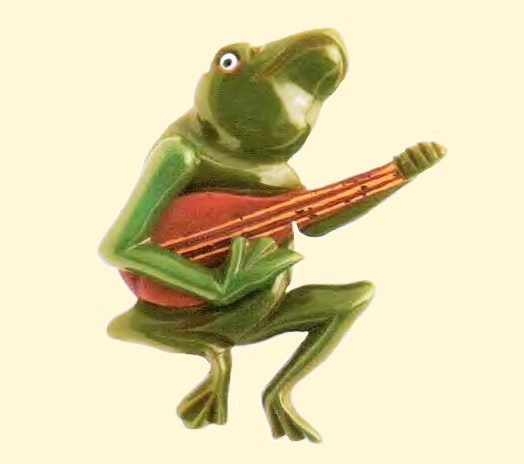
Frog playing banjo, Brooch. Green carved phenol, very rare. 1930’s. Unknown jeweler. 7 cm £ 1335-1665 BY










